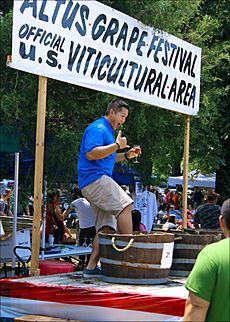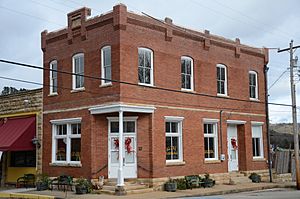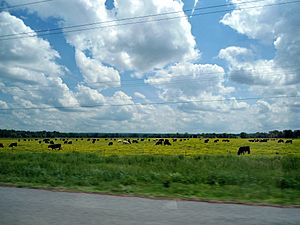Arkansas River Valley facts for kids
Quick facts for kids
Arkansas River Valley
The River Valley
|
|
|---|---|
|
Region
|
|

The River Valley as seen from atop Petit Jean Mountain in Petit Jean State Park
|
|
| Etymology: The Arkansas River | |
| Country | United States |
| State | Arkansas |
| Time zone | UTC−6 (CST) |
| • Summer (DST) | UTC−5 (CDT) |
| Area codes | 479, 501 |
The Arkansas River Valley (often called the River Valley) is a special area in Arkansas. It's named after the Arkansas River that flows through the western part of the state. This region sits between the Ozark and Ouachita Mountains. It's known for its flat, fertile farmlands and lakes, with tall mountains popping up here and there.
Three famous mountains – Mount Magazine, Mount Nebo, and Petit Jean Mountain – make up the Tri-Peaks Region. This area is super popular for hiking and enjoying the outdoors. Besides outdoor fun, the River Valley is also home to Arkansas's wine country. Plus, it has hundreds of historical places to explore. It's one of six natural areas in Arkansas.
Contents
What Defines the River Valley?
The Arkansas River Valley doesn't follow exact county lines. It includes all of Logan and Sebastian counties. It also covers parts of Conway, Franklin, Johnson, Perry, Pope, and Yell counties.
Smaller Areas Within the Valley
- Arkansas Valley Hills - These are north and east of the Arkansas River. Sometimes people think they are part of the Ozarks.
- Bottomlands - These are low, swampy, and grassy areas right along the Arkansas River. They can be about 10 miles (16 km) wide.
- Fort Smith metropolitan area - This includes Sebastian, Crawford, and Franklin counties in Arkansas. It also reaches into Oklahoma.
- Ozark National Forest - A small part of this protected forest is found in the region.
- Tri-peaks Region - This area is famous for its three steep mountains: Mount Magazine, Mount Nebo, and Petit Jean Mountain.
- Valley - This part is south of the Arkansas River. It has flat plains and gently rolling hills.
- Wine Country - This special wine-growing area is near the town of Altus.
A Look Back: History of the River Valley

Long before Europeans arrived, the River Valley was home to many Native American tribes. These included the Caddo, Cherokee, Choctaw, Osage, Tunica, and Quapaw tribes. Early explorers described small villages and farms, not large towns, in the River Valley.
We know a lot about these early people thanks to groups like the Arkansas Archaeological Survey. They found many artifacts at Carden Bottoms in Yell County. These findings connect to cave art on Petit Jean Mountain (pictured here). They also show links to the Caddo, Osage, and Quapaw tribes.
Hernando de Soto was the first European explorer to reach Arkansas in 1541. His group of 600 Spanish explorers was looking for gold. They explored the state for two years. In September 1542, they visited Tanico, an important city in the River Valley. The next month, they fought with a tribe called the Tula near Fort Smith. This fighting made de Soto turn his group back east, leaving the River Valley.
After the Civil War
After the American Civil War, the South's economy was in ruins. Arkansas faced many challenges, including damaged property and farms. Many parts of Arkansas became unsafe due to groups causing trouble. Even the governor had to declare a special state of emergency in some areas.
The River Valley was in a better position than some other parts of the state. It didn't rely as much on slave labor. This made it an attractive place for new settlers after the war.
Many people from Europe, especially Austrian Catholics and German Catholics and Lutherans, moved to the River Valley. Some came directly from Europe. Others came from earlier settlements in the Ohio River Valley. These new settlers helped found many small towns in the River Valley.
Many immigrants hoped to become rich by growing cotton. But the soil and climate in the River Valley weren't as good for cotton as other areas. So, many farmers started growing different crops like potatoes and other vegetables. This helped them avoid losing everything if the cotton crop failed.
Coal Mining and New Crops
Coal mining became an important industry in the River Valley around 1873. It was hard and dangerous work. Many Swiss and German immigrants who couldn't make their farms work became coal miners. The rolling hills reminded them of their home countries.
Because of the climate, good soil, and the immigrants' love for wine, several wineries started in the River Valley. The German community grew strong with coal mining and railroad jobs. Today, the Altus Area Coal Miner's Memorial honors over 2,500 local miners. Greenwood also has a Coal Miner's Memorial.
Over time, farmers in the River Valley shifted from cotton and timber to strawberries, hay, and cattle. But competition from other states made it hard to sell these crops. So, they looked for new crops. They tried beans, peas, and tomatoes before settling on mustard greens and spinach.
The Alma Canning and Evaporating Company, which had been around since 1888, started canning spinach and greens. In 1987, Alma proudly called itself the "Spinach Capital of the World." They even put up a statue of Popeye in front of their Chamber of Commerce building!
Geography of the River Valley
Cities and Towns
The biggest city in the River Valley is Fort Smith. It's the main city of the Fort Smith metropolitan area, which also includes Van Buren and Alma. Fort Smith is the second-largest city in Arkansas. It's a key center for culture, healthcare, and transportation.
About 84 miles (135 km) east, you'll find Russellville. It's an important city for the economy, education, and population in the state. Other towns in the River Valley are smaller. They often serve as gateways to nearby parks or are small farming communities. Towns like Booneville, Clarksville, Morrilton, Paris, and Perryville are important centers for their rural counties.
Weather and Climate
The River Valley usually has mild winters and hot, humid summers. Temperatures are generally warmer than in the Ozarks but cooler than in Central Arkansas. However, because the elevation changes a lot, the weather can be different from one spot to another. The western part of the River Valley, around Fort Smith, is close to an area called Tornado Alley.
Culture and Fun
Wineries and Arts
The vineyards and wineries around Altus have been run by the same families for generations. The first wineries started after the Civil War. They made wine for the Swiss and German immigrants who moved there to work in the coal mines. This tradition continues today with five wineries still open.
Chateau Aux Arc Vineyards and Winery is the largest producer of Chardonnay in the U.S. outside of California. Mount Bethel Winery has been open for over 100 years. Visitors can enjoy tastings, tours, and a gift shop. The Post Winery has been in the Post family for five generations. You can buy wines, tour the winery, and see how wine is made.
The Alma Performing Arts Center is the biggest and most popular place for shows in the River Valley. In Russellville, the Arkansas River Valley Arts Center offers art classes and sometimes performances. The Greenwood Performing Arts Center has over 1,000 seats for various shows. The Walton Fine Arts Center at the University of the Ozarks in Clarksville hosts university theater and speakers. The Stephens Gallery shows glass and ivory carvings. In Van Buren, the King Opera House is a restored opera house from the 1880s that now hosts many events.
Yearly Events and Festivals
The River Valley has many fun yearly events. These include festivals about art, history, music, and local traditions. Many events happen at state parks and in town squares.
Petit Jean State Park hosts a Wildflower Weekend in April and a Rendezvous after Thanksgiving. The Museum of Automobiles on Petit Jean Mountain has Antique Auto Show and Swap Meet events in June and September. Mount Magazine hosts an International Butterfly Festival in June and Frontier Days in October.
- Adona Bluegrass Festival in Adona, second weekend in July
- Fourche River Days in Perryville, April. This includes a car show and other festival fun.
- Global Village Day at Heifer International, October.
- Jammers Reunion in Adona, April. Another bluegrass festival.
The Alma Spinach Festival is held on the third weekend in April. It celebrates Alma's title as "Spinach Capital of the World."
In Clarksville, the Johnson County Peach Festival is the oldest festival in Arkansas. Held every July, it has a peach pit spitting contest and a turtle race, plus a parade and food vendors.
The Wiederkehr Weinfest in Wiederkehr Village is a free harvest festival held every October. It includes wine tasting, vineyard tours, music, polka dancing, traditional German cuisine, and other fun. It started in 1963 and is very popular.
Two big yard-sale events happen each year: Bargains Galore on Highway 64 and Big To Do on Highway 22. People along these highways sell items to visitors and locals.
County Fairs
- Conway County, September
- Johnson County, August
- North Franklin County, October
- North Logan County, August
- Perry County, September
- Pope County, September
- Sebastian County, August
- South Franklin County, September
- South Logan County, September
- Yell County, September
- Arkansas/Oklahoma State Fair (at Fort Smith), September–October
Museums to Explore
The River Valley has many museums that tell the stories of its early settlers, small towns, and important events.
- Altus Heritage House Museum (106 N. Franklin in Altus). This museum honors the early Swiss and German immigrants and the coal mining industry. It's in a restored German-American State Bank building.
- Arkansas Historic Wine Museum (101 N. Carbon City Rd in Paris). This museum shows the history of wine-making in Arkansas. It has old equipment for pressing grapes and making wine.
- Arkansas Tech University Museum (1502 N. El Paso Street in Russellville). This museum shows how Arkansas Tech University grew from a small agricultural school in 1909.
- Arkansas Tuberculosis Sanatorium Museum (256 Carey Rd in Booneville). This museum preserves a 1910 facility that treated tuberculosis. It became the largest in the U.S. by 1940.
- Charleston National Commemorative Site (125 W. Main Street in Charleston). This site honors the Charleston School District. It was the first public school system in the South to integrate (allow students of all races) in August 1954. This happened peacefully, which was very important.
- Fort Smith National Historic Site (301 Parker Avenue in Fort Smith). This site has two restored forts, a jail, and a courtroom. It tells the story of frontier life and justice in Fort Smith.
- John P. McConnell Exhibit (419 N. Kennedy in Booneville). This exhibit honors a former Chief of Staff of the United States Air Force during the Vietnam War, who was born in Booneville.
- Logan County Coal Miners Memorial and Museum (804 S. Elm Street in Paris).
- Logan County Museum (202 N. Vine Street in Paris).
- Old Jail Museum (305 E. Center Street in Greenwood).
- Ozark Area Depot Museum (103 E. River Street in Ozark).
- United States Marshals Museum (14 N Third Street in Fort Smith).
Protected Natural Areas
The River Valley has many protected natural areas managed by different groups.
Near Booneville, Blue Mountain Lake offers lots of fun activities. The Blue Mountain Wildlife Demonstration Area is a famous training center for bird dogs. Jack Creek Recreation Area and Knopper's Ford Recreation Area have popular Arkansas swimming holes, plus hiking, camping, and fishing.
Near Clarksville, the Spadra Waterfront Marina offers RV camping, boat rentals, and guided trips. North of Clarksville, Lake Ludwig is great for swimming, boating, and fishing.
South of Dardanelle, the Holla Bend National Wildlife Refuge protects over 7,000 acres (2,800 ha) of wetlands. It's a safe place for wintering waterfowl and other migrating birds. You can take a driving tour with signs explaining the area.
On the Fourche LaFave River near Ola, Nimrod Lake is known for crappie fishing and camping.
Near Ozark, Aux Arc Park offers boat access to the Arkansas River and RV campsites.
Ozark Lake, on the Arkansas River southwest of Mulberry, is surrounded by a Wildlife Management Area (WMA).
- Flatside Wilderness Area
- Illinois Bayou River
- Lake Dardanelle State Park
- Lake Overcup
- Mount Magazine State Park
- Mount Nebo State Park
- Mulberry River
- Ozark Highlands Trail
- Petit Jean State Park
- Shores Lake/White Rock Mountain
- Springhill Park Mountain Bike Trail
Outdoor Recreation
The United States Forest Service manages the Ouachita National Forest and the Ozark National Forest in this region. These forests offer thousands of acres for trails, camping, and fishing. Arkansas also has four state parks in the region: Lake Dardanelle State Park, Mount Magazine State Park, Mount Nebo State Park, and Petit Jean State Park.
Images for kids






